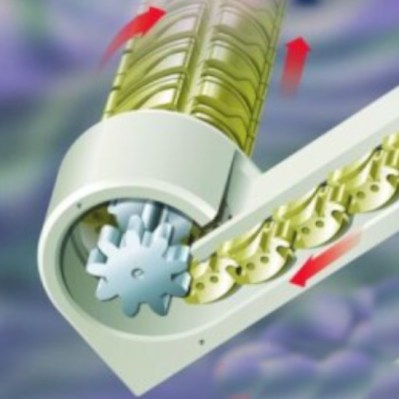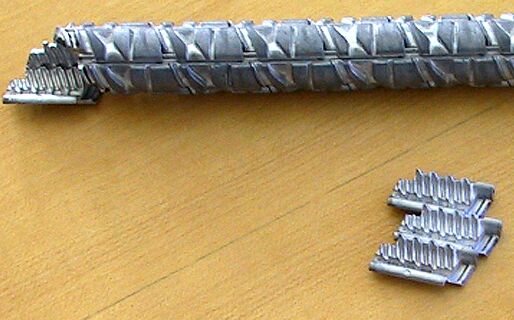Many of the projects we serve up on Hackaday are freshly minted, hot off the press endeavors. But sometimes, just sometimes, we stumble across ideas from the past that are simply too neat to be passed over. This is one of those times — and the contraption in question is the “Kataka”, invented by [Jens Sorensen] and publicised on the cover of the Eureka magazine around 2003.
 The device, trademarked as the Kataka but generically referred to as a Segmented Spindle, is a compact form of linear actuator that uses a novel belt arrangement to create a device that can reduce to a very small thickness, while crowing to seemingly impossible dimensions when fully extended. This is the key advantage over conventional actuators, which usually retract into a housing of at least the length of the piston.
The device, trademarked as the Kataka but generically referred to as a Segmented Spindle, is a compact form of linear actuator that uses a novel belt arrangement to create a device that can reduce to a very small thickness, while crowing to seemingly impossible dimensions when fully extended. This is the key advantage over conventional actuators, which usually retract into a housing of at least the length of the piston.
It’s somewhat magical to watch the device in action, seeing the piston appear “out of nowhere”. Kataka’s youtube channel is now sadly inactive, but contains many videos of the device used in various scenarios, such as lifting chairs and cupboards. We’re impressed with the amount of load the device can support. When used in scissor lifts, it also offers the unique advantage of a flat force/torque curve.
 Most records of the device online are roughly a decade old. Though numerous prototypes were made, and a patent was issued, it seems the mechanism never took off or saw mainstream use. We wonder if, with more recognition and the advent of 3D printing, we might see the design crop up in the odd maker project.
Most records of the device online are roughly a decade old. Though numerous prototypes were made, and a patent was issued, it seems the mechanism never took off or saw mainstream use. We wonder if, with more recognition and the advent of 3D printing, we might see the design crop up in the odd maker project.
That’s right, 3D printed linear actuators aren’t as bad as you might imagine. They’re easy to make, with numerous designs available, and can carry more load than you might think. That said, if you’re building, say, your own flight simulator, you might have to cook up something more hefty.
Many thanks to [Keith] for the tip, we loved reading about this one!
















I think it grows, rather than crows!
A tuned antenna comes to mind as one application area.
The solid equivalent of a liquid metal antenna.
Exactly what I was thinking! See http://www.steppir.com
Cheers,
NV1T
Also see the Spiralift Telescoping Linear Actuator video: https://www.youtube.com/watch?v=c-7b1b2R_Kg
It looks like a horizontal slinky together with a watchspring spiral. Well worth a watch.
Cheers,
NV1T
Mary Poppins actuator
It’s a neat idea though their “flat force curve” is a bit of a marketing gimmick as it is entirely dependent on the particular installation geometry.
It’s also not a “unique advantage”, because rigid chain, rigid belt, and helical band actuators all share that property.
http://www.spacenet.on.ca/data/pages/canada-in-space/alouette.html
STEM antenna, a related idea
Agh, accidentally reported the comment when I wanted to reply! Sorry.
About that, it is the same mechanism used in the Viking probes to extend the arm that recollected soil samples.
Hitting Reply or Report is too easy when viewing on a smartphone, especially when using one handed & scrolling
I found this chanel with a lot of videos.
https://youtube.com/user/kataka1
A patent protects the filer from other people using it. While the patent is active and nobody else uses it, well, it isn’t going to see widespread use. There are plenty of examples of this out there. The moment things go off patent, generic alternatives of good ideas suddenly spawn. Some of which are much better than the original, even if it is in widespread use. 3D printing is one great example.
There might be other reasons why things don’t catch on as well but typically patents don’t exactly encourage widespread use.
That’s why you outsource your production to China, if it’s new and innovative, it’ll be VERY popular.
Seems like the type of mechanism suited to space probes where small compact size for transport is preferred which unfolds in to a larger structure.
This kind of mechanism is super cool. An even more space efficient version is called Spiralift
https://youtu.be/c-7b1b2R_Kg
Sort of how a zipper grows.
Other similar mechanisms:
Storable Tubular Extendable Member (STEM): often used for deploying long antennas. Used in satellite applications since the beginning: First used on Canada’s Alouette in 1962.
Coilable Lattice Truss: a triangular tensegrity structure of tension and compression members
A great overview of a bunch of similar mechanisms: http://www-civ.eng.cam.ac.uk/dsl/publications/TR198.pdf which is prefaced by the teaser: …there is a requirement for remotely operated inspection devices with a horizontal reach of 5 m that fit inside access tubes with diameter of 0.2 m, that are able to support a tip mass of 2 kg …
Kind of a “helical zippermast” that should be a lot stronger, clever!
Does it handle negative loads? I mean, if it’s turned upside down, will the mechanism fall apart?
The original Spiralift does not handle tensile loads – it is generally for lifting things like theatrical stages. They have a follow-on with toothed coils that does handle push and pull.
Witchcraft!
Heh .. nice one…
But the idea is already _very_ old… And one implementation of that concept actually came from Conrad Zuse himself:
http://zuse.zib.de/helixTower
https://www.youtube.com/watch?v=odwgpKRnWM8 ;)
I wonder how big you could built that. In my mind I’m picturing 25 mm (~1″) thick steel bars for the framework.
Did you learn about that with this past comment too https://hackaday.com/2020/12/08/3d-printed-rigid-chain-mechanism/#comment-6301328 ?
@HaD: Please add the tag “Linear Actuator” to that article too. Thx
Done!
Something you would see on Mission Impossible…
Reminds me of the “spiralift” such as: https://www.pacospiralift.com/solutions/spiralift-solutions/
A 99% similar mechanism is used as a window opener. The retractable chain making for a smaller box.
Still waiting for a cheap enough china clone to automate all my windows with.